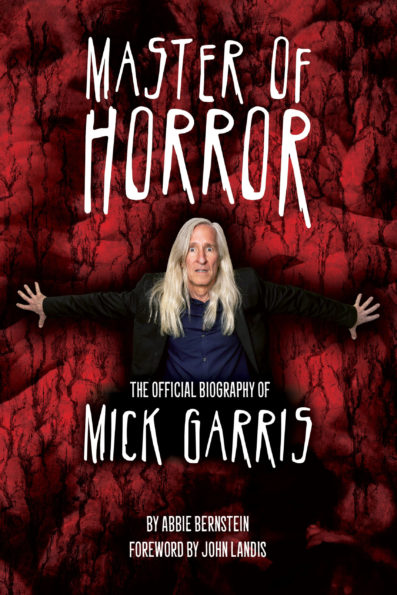 By ABBIE BERNSTEIN (ATB Publishing; 2021)
By ABBIE BERNSTEIN (ATB Publishing; 2021)
Mick Garris may not mean much to mainstream audiences, but he’s a legend in the horror community. A former publicist turned screenwriter, director, novelist, producer and podcaster, Garris can be said to very nearly be all things to all people (all horror people, that is).
Mick Garris…is a legend in the horror community.
This long-in-coming biography by journalist and filmmaker Abbie Bernstein, MASTER OF HORROR: THE OFFICIAL BIOGRAPHY OF MICK GARRIS, is as thorough a portrait of Mr. Garris as anyone could desire. It may actually be a bit too thorough in its lengthy examination of each stage of its subject’s life, and every film and TV program he’s directed (including episodes of NEW YORK UNDERCOVER, PRETTY LITTLE LIARS and ONCE UPON A TIME, each of which is voluminously covered in these pages). This means the book probably won’t appeal to readers who don’t have a rooting interest in Mick Garris or the modern horror scene.
It begins with an introduction by Garris’ longtime pal John Landis. It was Landis, we learn, who (along with other famous friends like Steven Spielberg, Joe Dante and Stephen King) was largely responsible for Garris’ rise to the top, offering a plethora of recommendations and praise along the way. Another contributing factor to Garris’ ascent was his near-inhuman amiability; he’s often called the nicest guy in Hollywood (having named his production company Nice Guy Productions) and this book confirms that.
Another contributing factor to Garris’ ascent was his near-inhuman amiability;
This of course means we get none of the sordid tales of sex, drugs and abuse that tend to drive most Hollywood bios (another reason this book won’t appeal to everyone). The book’s portrayal of the 1970s rock scene, in which Garris was active in his youth, may well be the only one ever written that doesn’t involve groupies or substance abuse, while Garris’ early misadventures in Hollywood, working as a story editor on AMAZING STORIES, is unusual in that it doesn’t involve him raging about his employers’ lack of artistic integrity (although he’d have been justified in doing so). Even his romantic life is scandal-free, with Garris having married his actress wife Cynthia back in 1982, and remained faithful to her ever since.
One area in which this book is quite revealing is in Garris’ recollections of his collaborators’ on-set demeanor. From Anthony Perkins’ “testing” of Garris on the set of PSYCHO IV to actress Laura San Giacomo presenting him with rewritten script pages on the first day of shooting THE STAND miniseries to having to contend with Dario Argento’s limited grasp of English on his segment of the Garris produced MASTERS OF HORROR cable anthology series, many never-before-told Hollywood tidbits are divulged in these pages.
In keeping with the book’s thorough gist, we get plenty of info on MASTERS OF HORROR. Included are synopses and behind-the-scenes chronicles of each episode, as well as info on the famous get-togethers that inspired the series, with Garris, the self-described “Rolodex of horror,” convincing quite a few genre luminaries to take part in vast dinner parties.
One portion of this book that isn’t as in-depth as I’d have liked is chapter 20, which deals with Garris’ career as a novelist and short story writer. If you ask me, Garris’ books, which include the novellas UGLY and TYLER’S THIRD ACT, and the anthology A LIFE IN THE CINEMA, are his most enduring accomplishments, and deserve far more than the measly ten page overview Bernstein provides. This reflects the attitude of Garris himself toward his fiction; as Clive Barker (another Garris confidante) is quoted as saying, Garris “isn’t dismissive (of his prose writing), but he’s not as celebratory of it as he should be.” The same can be said for MASTER OF HORROR overall.
